As Paddington 2 hits cinema screens, Jo Kessel heads to deepest, darkest Peru for a thrilling mother and son adventure
I remember watching a video about the Amazonian jungle in primary school. It was fascinating and exotic. I longed to go there, but it seemed too distant, too expensive and too improbable. Forward wind 30 odd years and I’m sitting next to my son Gabriel, 13, on a motorboat sailing along a tributary of the Amazon in Peru, so low to its taupe-coloured waters that if there weren’t piranhas lurking beneath us we could and would dip our fingers in.
It’s a surreal moment which came about thanks to Gabriel craving more adventure than a fortnight on the Med. That and a new, direct British Airways route from London to Lima sealed the deal. My childhood dream would be fulfilled.
An overnight stay in Lima followed by a short domestic flight to Puerto Madonaldo – gateway to the southern Peruvian jungle – and here we are on the river (second longest in the world after the Nile) which carves a 4500-mile trail through dense tropical rainforest, starting in Peru’s Andes and flowing east towards the Atlantic Ocean. We’re en route to Inkaterra Reserva Amazonica, an eco-friendly luxury boutique hotel set in the heart of the jungle. It’s so ‘eco’ that its 35 thatch-roof cabanas (their walls are made from surrounding trees) are camouflaged and hard to spot from the boat.
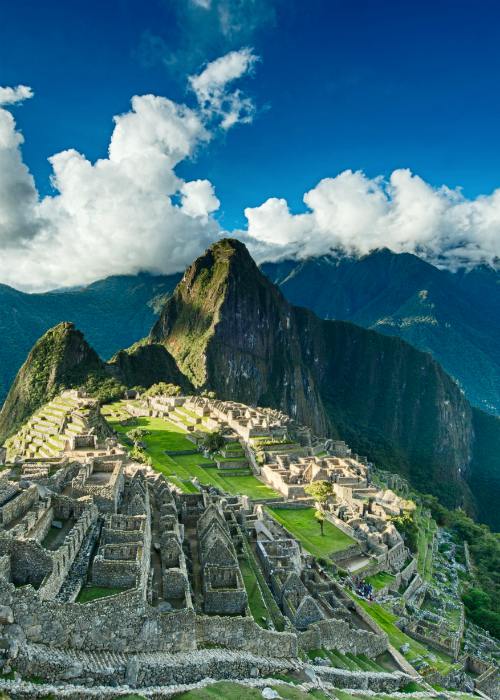
Beautiful panorama overview above the world heritage site
At a briefing meeting once there we’re told our visit is carbon neutral (electricity is low-impact and limited in the evenings) and are introduced to a menu of excursions included in the hotel’s price, led by their team of guides – jungle treks and river trips, all offering flora and fauna-viewing opportunities. We plan our itinerary for the next forty-eight hours and after lunch in the main lodge (meals are included too) we find our cabana which overlooks the river.
Its porch boasts two hammocks, one of which Gabriel instantly lowers himself into, lazing as he watches brown-furred agouti (they resemble giant guinea pigs) scuttle across the jungle floor whilst tropical butterflies flutter past. Happily the sun sets early because our first adventure is a twilight river excursion.
Boarding our motorboat soon after 6pm we’re shrouded in an eerie blackness – the only light is a dazzle of constellations in the inky sky.
The driver uses a heavy-duty torch to guide his path and pick out wildlife. First a posse of baby white spectacled caimans, whose eyes glare in the dark; next the world’s biggest rodent, a capybara. The driver cuts the engine. “Let’s meditate for two minutes,” he says. In our silence the noise of wildlife communicating is deafening – a multi-layered nocturnal symphony punctuated by hooting.
The next morning we wake to a similar, thrilling symphony and a scratching noise underneath our cabin – an agouti, perhaps? Red flares through a window. “Something’s burning.” I dash outside and laugh at my stupidity. What’s blazing is the sun, a fiery blood orange rising above the Amazon.
We’re so far from civilisation there’s no phone network let alone wi-fi, and after breakfasting on freshly-baked breads and coffee we’re taken to new heights – thirty metres to be precise.
The hotel has built a walkway high in the rainforest canopy, enabling a close-up view: monkeys bouncing from branch to branch, so fast it’s hard taking decent photos; a wasp nest the size of a punch bag dangling from a tree; birds with vivid coloration. Our guide carries an illustrated book so we can match sightings to pictures.
Excursions are fun and intimate (no more than eight guests) with downtime in-between to chill in a hammock and enjoy a meal. Cuisine is tasty and inventive, using local, organic ingredients.
I’ve become partial to the Peruvian grain quinoa, used in salads, pancakes and breads, but my favourite is paiche, a large white-meat fish native to the Amazon. It comes served in a palm leaf or in a spicy stew which reminds me of bouillabaisse, only it’s better.
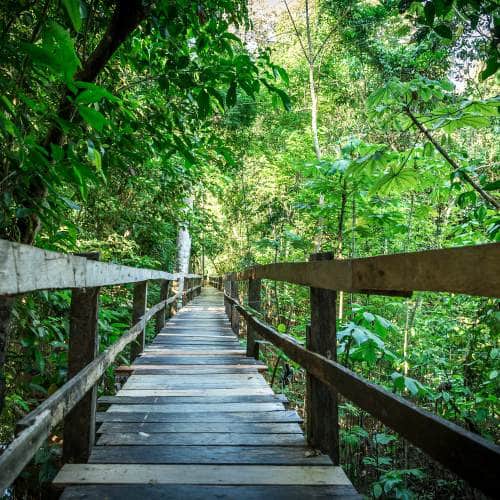
Tropical rainforests lead to exclusive resorts
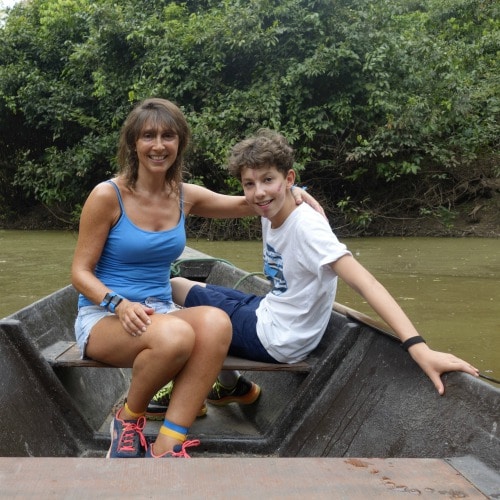
Private rainforest excursions
The next two days are thrilling. We cross the jungle for miles on foot and in boats, spotting different monkey species (some endangered), caiman, tarantulas, toxic toads, giant turtles, otters, cormorants. We eat star fruit and cashew nut fruit fresh from trees; termites too. The guide insists the latter are excellent protein so Gabriel tries one. “Tastes like bark and mud.”
Inkaterra has half-a-dozen luxury hotels across Peru and our third night is spent in their second, smaller jungle hotel, the Hacienda Concepcion, a fifteen-minute boat-ride away. Here cabins are built on stilts and there’s a lagoon good for piranha-fishing. We use primitive rods and beef for bait. Within minutes (beginner’s luck) we’ve hooked one and examine its scarily sharp teeth before throwing it back in. Three days is enough in the jungle and leaves time in our week-long trip to visit another Peruvian treasure: Machu Picchu.

Machu Picchu on a sunny day
To reach this ancient Incan citadel high in the Andes requires a forty-minute flight to Cusco, whose 3,400m elevation makes us light-headed and breathless. Our tour operator Aracari (named after a yellow-beaked toucan we saw in the jungle) proves our saviour, sending a car and guide to ply us with coca tea (a local remedy for altitude sickness) as we drive to our hotel, the Hacienda Urubamba. It’s halfway between Cusco and Machu Picchu in the Sacred Valley, where we’re surrounded by dramatic, arid, Andean peaks.
It’s the perfect place to acclimatise and the next morning, when our Aracari guide Fredy arrives, we’re raring to go. It’s possible to do a three-day hike from here to Machu Picchu along the infamous, twenty-six-miles-long Inca trail, but we take a scenic train journey through the Andes instead. Then, after a short bus ride, we’re staring at this fourteenth century marvel.
It’s so epic it’s hard to believe we’re here. We drink in the mountains circling us, their summits all equally high at 2,400m and carpeted with cloud forest. How did the Incas clear the vegetation on these sheer slopes let alone build an advanced city without modern equipment? No surprise it was voted one of the new, seven wonders of the world.
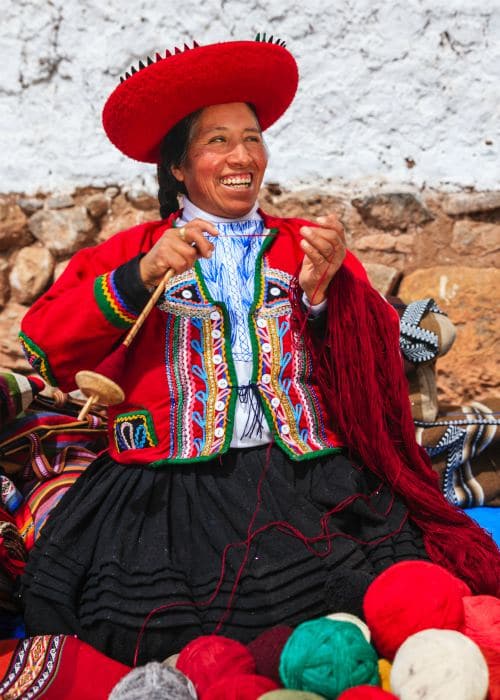
Peruvian women craft alpaca fiber goods
Fredy shows us how the Incas constructed walls without cement, so strong they’re still standing six hundred years and several earthquakes later; and how their architecture and trademark terraces were in harmony with the mountains they worshipped.
Machu Picchu is known as the ‘lost Incan city’ because the Spanish (who conquered the Incans) knew it existed, but never found it. Gabriel’s fascinated not just by the history, but by llamas roaming the ruins, extremely uncooperative when he tries taking a selfie with them. Less amusing is learning the Incas sacrificed girls as young as fourteen to their mountain-Gods.
Our final day is equally exhilarating and memorable.
A vertiginous hike up Machu Picchu Mountain (Fredy sets the pace perfectly) takes two lung-busting hours to summit, but the ‘on-top-of-the-world’ view from 3082m is worth the effort. Afterwards we barter for alpaca socks and gloves at a local market before returning back to our base, the Machu Picchu Pueblo Hotel, to visit its tea plantation and bear sanctuary. The Andean spectacled bear is endangered and the hotel rescues neglected animals to release back into the wild.
For our last supper Gabriel tries local delicacy, cuy – guinea pig – and declares it tastes like duck. And I drink my first Pisco Sour, the country’s national cocktail. We toast our amazing Amazonian adventure and not only do we vow to come back, but we promise that next time we’ll challenge ourselves further by hiking the Inca Trail.
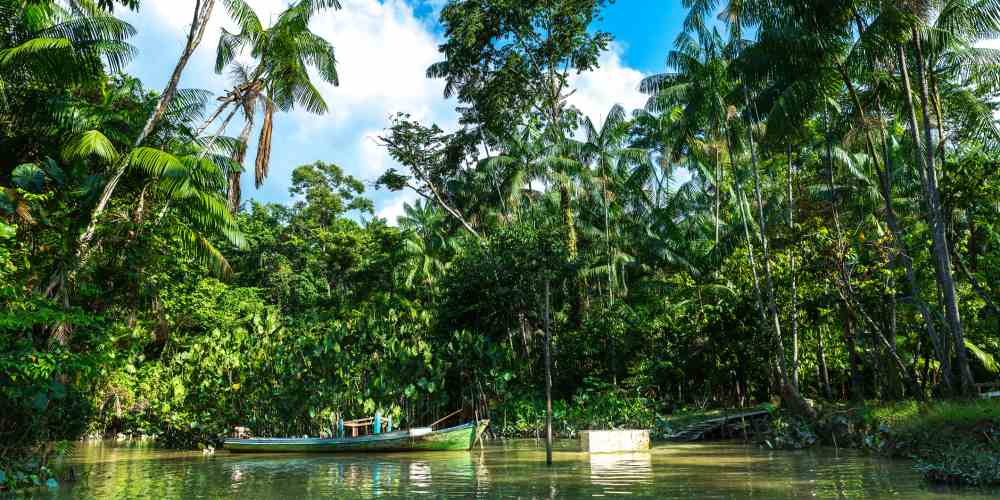
Brave the humidity for a trip through the Amazonian rainforest
Gabriel’s take on Peru
Being a 13 year old boy, there are only so many times you can be satisfied with laying on a beach for a week. I wanted more adventure and Peru is really cool, with three different ecosystems: mountains, rainforest and coast. Lima, on the coast, was great for a night, but when we got to the jungle was when the real adventure started for me. From walking up on 30m high suspension bridges seeing everything from macaws to wasps nests bigger than I am, to canoeing on a lake watching the sun set. Mum spotted a tarantula on a twilight walk and she was terrified. And I managed to get bitten by a fire ant and the bites feel like fire! Standing by (under) a 500-year old Ironwood tree, which was over 60m tall, we were told that ONE tree in the rainforest has more ant species on it than there are in the whole of the British Isles.
After three action packed days neither of us wanted to leave, but the mountains were waiting for us and they didn’t disappoint. After a night in the Sacred Valley, we found ourselves at the Machu Picchu ruins, where the Incas lived. We walked around taking in the 500-year old history. The stonework is amazing.It is one of only a few spectacular ruins in the world where cement was not used – instead they put tiny rocks into the gaps between the big ones.
After exploring the ruins for three hours we realised that we were the last people left on the site at closing-time and that was very special. The next day we did a four-hour trek up Machu Picchu Mountain, 3000m high. Mum was huffing and puffing but I was just fine! After an exhilarating week it was time to go home, but don’t worry Peru, I will be back!
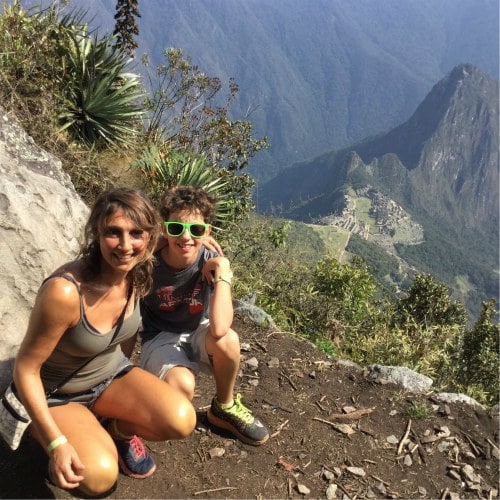
Amazing views make the four-hour hike worthwhile
How to get there: British Airways flies direct from Gatwick to Lima twice a week from £516.00 return. The flight is 12-and-a-half hours and Peru is six hours behind, but there’s lots of onboard entertainment to occupy the children. It’s best to be up to date with tetanus, typhoid and hepatitis jabs. Yellow fever and anti-malarial pills are recommended for the jungle.
Getting round an where to stay: Peru luxury travel specialist Aracari (+511 651 2426) organises tailor-made trips. A 7-day trip to Peru including stays at the JW Marriott Lima, Inkaterra Reserva Amazonica, Inkaterra Hacienda Concepcion, Inkaterra Hacienada Urubamba and Inkaterra Machu Picchu Pueblo Hotel costs £6,898 for one adult and one child under 11. This includes all ground transfers, trains, guides, activities, a private guided tour of Machu Picchu and some meals. Domestic flights for the whole trip start from £910 per person.